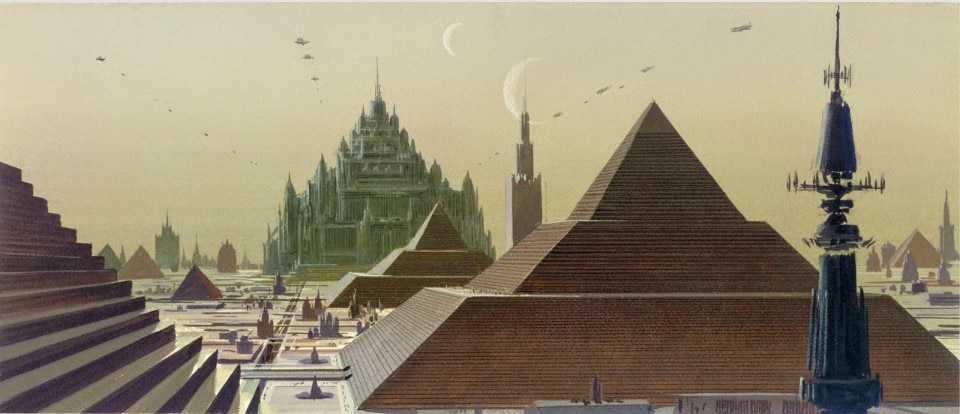The world of Star Wars does not have a unique architectural style because there is no such thing as a single world in Star Wars. Its vocation is to narrate the broad great part of the galaxy and therefore parallel worlds that differ in creation (the different trilogies) and in location (the various planets, each with its own history, climate and civilisation). It is in all respects the greatest effort cinema has ever made to build its own universe starting from design and not from the plot. It is a vision of a very remote future of cities, suburbs, villages and offshoots of different parts of our world. It is important to keep in mind that not only is our planet the only one we really know, hence our sole inspiration, but also that a film like Star Wars is shot in our world. It is not an animated film nor a film like Avatar (made of virtual sets), but one in which the actors have to be on real sets. Therefore, the locations can only be deserts, forests, cities and all the other places found on planet Earth but that, at times, we do not recognise as such.
The role of Ralph McQuarrie
On this basis, the work done to diversify the planets was, since the beginning, very much linked to architecture, to how the beings who inhabit them have built and organised their social life. Lucas' objective was to give the story its own personality, to differentiate the film from all the others, as he had done successfully in THX 1138 (whose success had been mainly for its design). The result went far beyond his intentions in terms of its ability to influence the actual design of our world and the ability of cinema to create an imaginary world starting from projects that were first and foremost functional, whether for buildings, vehicles or uniforms. And the credit for this goes essentially to Ralph McQuarrie.
Star Wars is in fact one of the few cases in the history of cinema that a film was written together with a designer, Ralph McQuarrie to be exact.
Star Wars is in fact one of the few cases in the history of cinema that a film was written together with a designer, Ralph McQuarrie to be exact. Lucas had to convince 20th Century Fox to invest in his idea, and to facilitate the decision he thought of starting with the illustrations instead of the plot (still a work-in-progress), showing them what that world would look like before having a proper story. So McQuarrie entered the scene almost immediately and after Star Wars was approved continued to play a crucial role in shaping that world and influencing the plot. For Lucas, design wasn't just a matter of style but a way of suggesting a wider world than the one in just one film.
From Tatooine to Rem Koolhaas
The first encounter with the architecture that would dominate the original Star Wars trilogy is the gigantic vehicle that Luke runs into and retrieves the droids from. A vehicle that looks like a tall rubbish truck and a perfect example of what the film would stage from then on: brutalism applied to science fiction. It is no coincidence that in 1998 the vehicle only had to be slightly altered to become Rem Koolhaas' Casa da Música in Porto or the headquarters of Lucasfilm in Singapore.
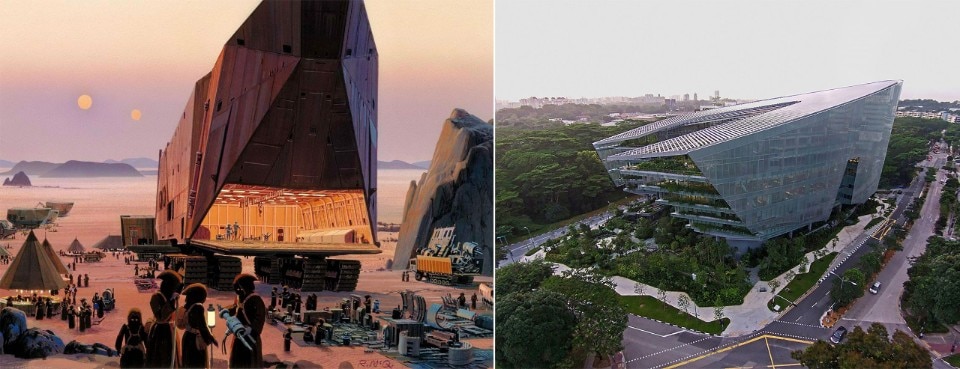
The first trilogy is mostly inspired by Brutalism per se for everything other than the royal and religious buildings (which are also somewhat contaminated by it). Tatooine, the desert planet where Luke Skywalker lives, is a triumph of brutalism inspired by Tunisia where those parts were actually filmed. The igloos where Skywalker's adopted family lives, like Mos Eisley where we meet Han Solo, are in fact brutalist installations that simulate the granaries of Ksar Ouled Soltane. There's all kinds of rusty technology adorning it of course but that's the inspiration.
If, for the interiors of the spaceships, especially the Death Star, the ultra-thin reflective surfaces of 2001: A Space Odyssey were the inspiration (and it's no coincidence that Lucas hired Colin Cantwell, who had worked on that film, as designer), that perfectly rounded shape with a loop at the top is itself a brutalist idea that underscores the materials. It appears to be as a single block, a boulder that wanders in space pretending to be a planet, animated as if it were a city. It is almost more beautiful in its second (unfinished) version than in its first, complete one. It is not by chance that the geometric simplicity of its spherical design makes it immediately memorable because it is very close to the direction our architecture was taking in those years. So much so that it inspired the design of Adam Marcus’ Rak Convention Center.
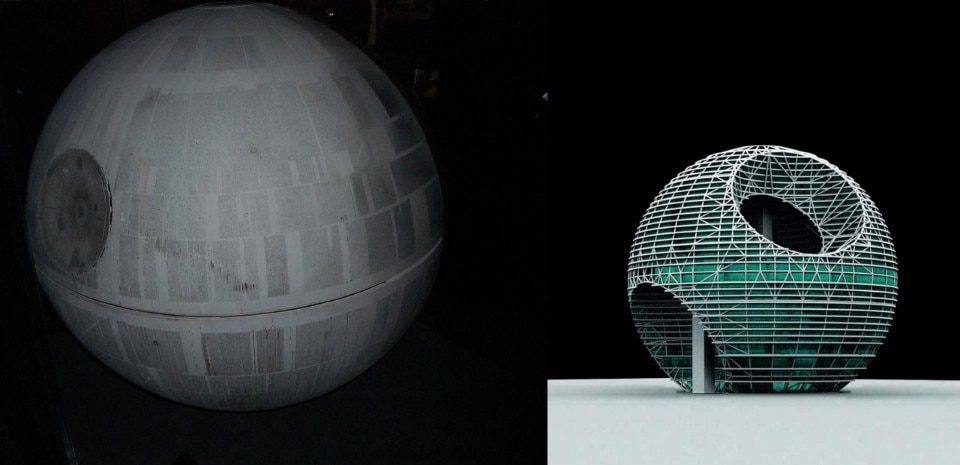
The beautiful, the ugly, the Empire
In that first, preparatory phase of the film, made up of sketches and illustrations, McQuarrie had actually created the entire look of the film and once production got underway all they had to do was to shoot it. This was where Lucas' idea came in, at the time an even bigger revolution than the prominence of design in the preparatory phase: the idea that everything should look used, the buildings ruined and the uniforms shabby (all except the Empire's). He stole it from Leone, who had invented the sweaty, dirty and shabby West, only when applied to science fiction it created a lived-in world, almost as if it had been filmed there in the real environments of the galaxy. A very strong sense of realism in a film that was totally unreal, created a strange and particular marriage between those close-up shots of half-broken helmets or ruined chessboards, technologies that worked or didn’t, and then the grandiose whole. The views and the buildings, as well as the fantastic city in the sky of planet Bespin that you see in The Empire Strikes Back.
The inspiration for that was John Lautner's Chemosphere House built twenty years earlier. The film takes that idea to extremes and adds a vaguely Byzantine twist to it (which is the design idea behind many of the non-threatening buildings in the first trilogy). Here we find a theme which is typical of science fiction building construction, namely vertical design. Even though the one run by Lando Calrissian is a city that develops horizontally (with a diameter of 16 km!), in reality at the bottom are the mechanical parts and at the top the residential neighbourhoods that benefit from the work being done underneath them (as Metropolis taught us and Blade Runner would repeat, differentiating clearly the design of what is above from that at street level).
The Empire Strikes Back also contains another great architectural idea: the base inside the ice on planet Hoth you see at the beginning of the film. It is a shelter complete with everything, from the hangar to the offices. Everything is carved in snow, in perfect harmony with an environment that cannot be altered but only embraced. It hides and serves as a shelter, as seen in the section.
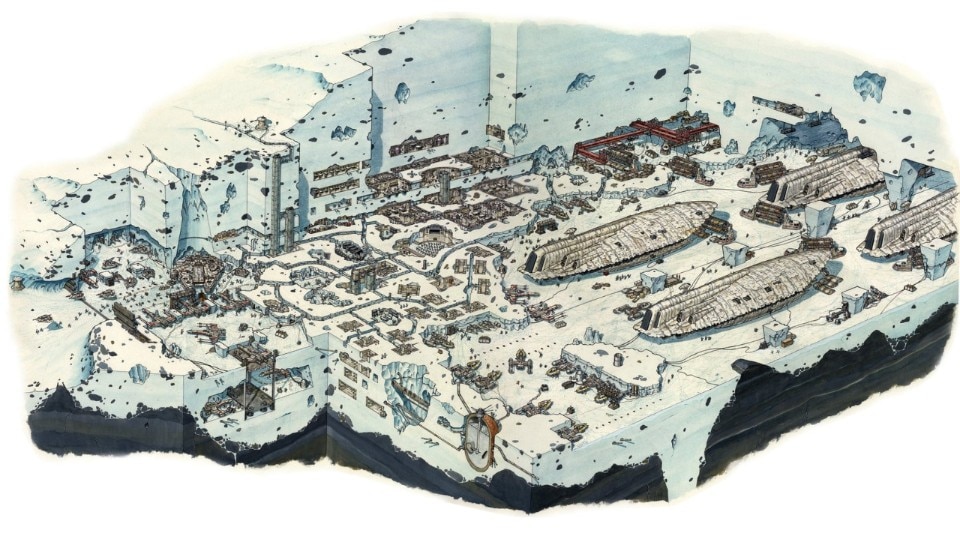
Finally, in Return of the Jedi there is the last of Star Wars’ great pieces of architecture, Jabba The Hutt's palace. Conceived as a temple, with round, brutalist forms merged with Byzantine inspirations (like the Hagia Sophia or the Blue Mosque in Istanbul, which resemble it very much), it has an incredible charm and speaks of distant and exotic worlds. The main room where Jabba lives has an exceptionally wide curved entrance, while the halls are not as large as one might imagine given the owner's megalomania. It looks like a piece of industrial design (C3PO says it looks more like a foundry than anything else) restored and adapted for other uses, but its beauty is timeless. Curiously, only a few years earlier the construction of the Śnieżka Meteorological Observatory in Poland, which is very reminiscent of it, had been completed.
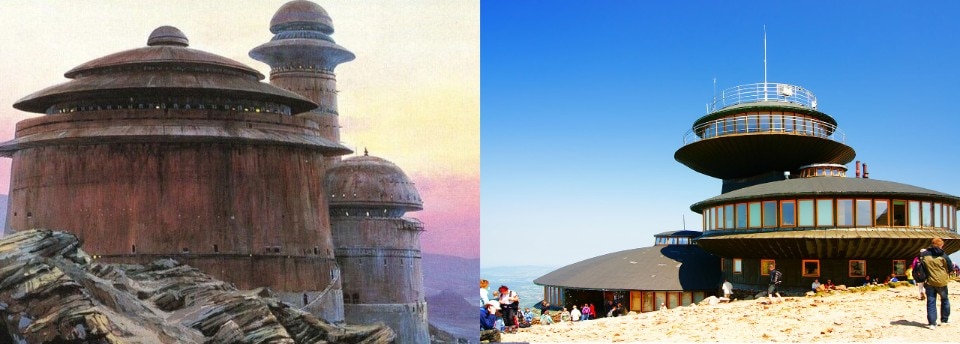
Between New York and Singapore, with a touch of Blade Runner
Contrary to what one might imagine, the second trilogy did not take any steps backwards compared to the first. On the contrary. The need to work on an expanded universe led Lucas to show the world previous to the events he had already told as more teeming, dense and complex. Each environment must give the impression of hosting more stories than the one we see, or of actually having its own story. Pursuing the idea of a clear and functional design for each planet, one that suggests not only the uniqueness of that place but also how the structures can enable and organise life there, the Art Nouveau city of the Gunga (Jar Jar Binks' race) is born, and most importantly Coruscant is born.
Coruscant is the capital of the old Republic, taken directly from the concept of Ecumenopolis conceived by Greek town planner Constantinos Apostolou Doxiadis: a single city as big as an entire planet, result of centuries of wild urbanisation and different megalopolises merged together. The centre must be as dynamic as possible. Coruscant obviously resembles our most crowded metropolises, combining the classic New York skyline with the more modern one of Kuala Lumpur or Singapore, it is layered, you fly through it and it is so densely populated that we are practically never shown the street level. We only see the views. Echoes of Western civilisations with tall spires that look like minarets.
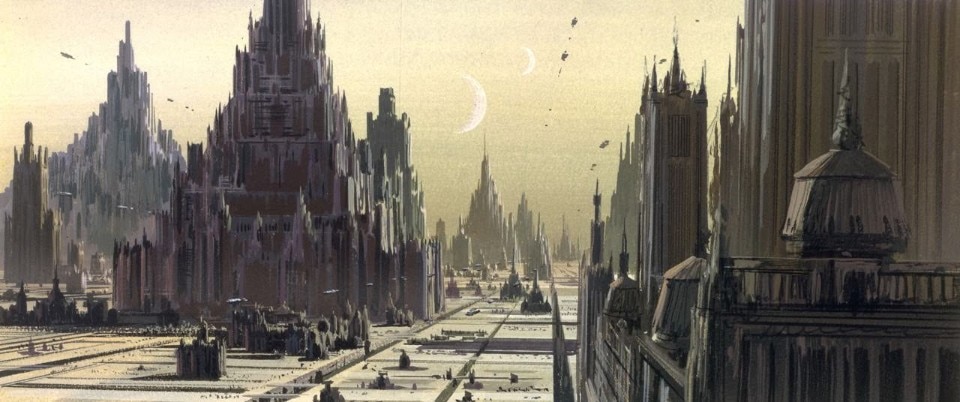
As the capital city, Coruscant is home to some exceptional buildings. The first is the Jedi Temple, conceived as a Mayan pyramid with spires on top. No doubt influenced by what Syd Mead had done for Los Angeles in Blade Runner and its pyramids (MacQuarrie's early drawings are unmistakable), it goes one step further. The size is clearly greater than the other buildings around it, a kilometre high, it is designed as a stronghold even though it is a place of worship, combining the need to defend with the idea of training a generation of Jedi in the art of combat. There is the welcome and grandeur of almost an educational building, the magnificence of the great mosques and the feeling of a fortress. As for the internal layout, as always in Star Wars, the most important areas are decentralised, in this case the towers. Since the first trilogy, according to the design, in any structure what matters is never located in the main body of vehicles or buildings, nor in the largest one (think of the cockpit from which the Millennium Falcon is piloted, located at the side) and here too it is on top of the towers that the crucial scenes take place.
Finally, Coruscant is also the seat of the senate, a structure that today may be reminiscent of the Louvre in Abu Dhabi), which inside has the gigantic chamber in which all the populations of the galaxy have a seat. 1024 floating seats, all of the same type, visually symbolising equality. In the centre is a very high podium on which the supreme chancellor sits. The sight is stunning and gives an idea of what a galactic republic can be. Something between a flower bulb and a solar accumulator.

Of lesser visual impact, but of great narrative impact, is the plasma refinery on Naboo, where at the end of The Phantom Menace Qui Gon Jinn and Obi Wan Kenobi fight Darth Maul. A place to work, not to live in, it is made up of machinery and a compression system that creates the self-closing compartments used to animate combat. Most importantly, as often happens in Star Wars, it is a refinery that extracts plasma from the centre of the planet, so it has precipices where anything that falls is lost forever. Because in Star Wars when something ends, a hand, an emperor or a victim, it always falls until it disappears.
And although Lucas had nothing to do with the third trilogy, a lot of his design obsessions can be found there too.
When design comes first
Every element of this fictional future has to suggest a story behind it, and this also applies to the design of the single vehicles, such as the speeder Luke Skywalker rides on Tatooine, a wrecked convertible that looks 100 years old. Here again Ralph McQuarrie's ideas are very clear, combine the need to represent machines as animals, especially the Empire's vehicles seen in the first trilogy (which look like elephants, chickens or insects in the case of the tie fighters), with a functional idea. His designs look more like prototypes for production rather than ideas for something no one will ever build. The tunics of the empire officials travel between Moebius and the Vatican, while the original vision of Darth Vader, with the mask revealing more directly his breathing respirator, reveals that in a first draft supposedly he would need it to survive in space.
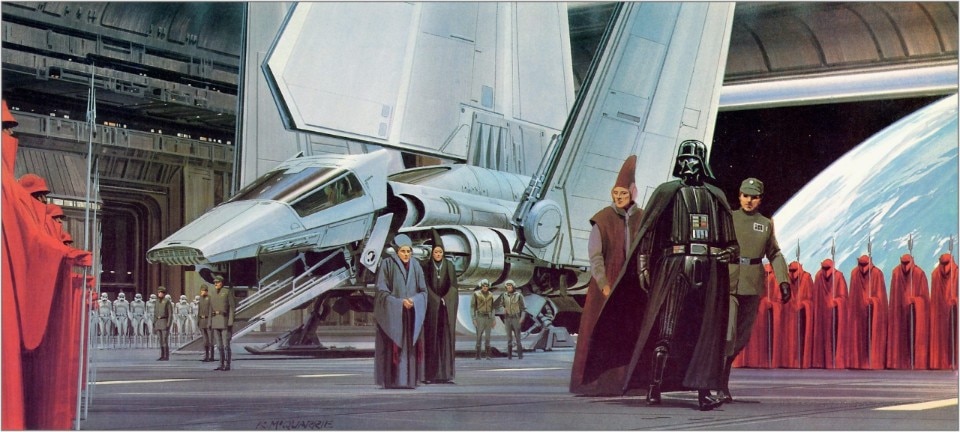
Created before the screenplay, the sketches and drafts of Star Wars reveal the true nature of many ideas, later modified and passed through the duties of storytelling, but conceived first of all to evoke. And this is what the trilogy has always done, evoke something else: a world full of possibilities.
Opening image: Had Abbadon by Ralph McQuarrie. Credit: Abrams Books and Lucasfilm Ltd. & TM. All Rights Reserved


